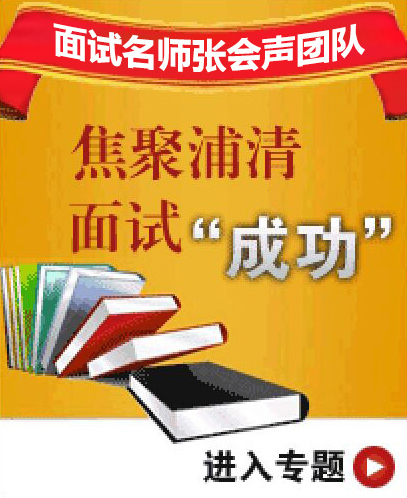?
Home page title
2011國家公務員考試申論熱點:國人的"狀元情結"
每日時評:由北大招生看教育公平之難
近日,在報上讀到兩則與數字有關的消息:一是北大教授潘維在接受Alec Ash采訪時說,上世紀50年代、60年代北大70%是農村學生;今天,這個比例已經不足1%。另一是今年高招北大原來計劃在京招生256人,實招368人,擴招112人(擴招率44%)。
毋容置疑,改革開放以來,我國國民經濟發展了,我國的教育事業也發展了,高等教育的普及率也大大提高了;但是由于經濟發展的不平衡,地域的差異、城鄉的差別也拉大了,而教育資源的不均衡,教育的不公平也加劇了。
這些年隨著農村城市化步伐的加快,部分農村人口成了城鎮人口,農村學生的比例相對縮小了,加上一些農村子弟棄學、棄考,過早地加入“打工大軍”,也使得應考的農村學生減少了,這是客觀的事實。但是,除了生源數量的減少,還有更深層次的原因。
例如上學的高收費、大學畢業的就業難,使得一些經濟尚欠發達的農村地區、偏遠地區家境貧寒的學生棄學棄考,“流失”了一些優秀學生;城鄉教育資源的不均衡,造成部分地區農村教育質量遠遜于城市教育,“埋沒”了一些有發展潛質的學生;而近年來不少城市“名校”之間惡性競爭,他們用所謂的“獎學金”和“轉學”、“落戶口”為釣餌,到縣鄉鎮學校“掐尖”,把優秀的中考生、高中生挖走,用來提高學校的升學率,“轉移”了一些高素質的學生。如此一來,經過一層層的自然淘汰,一次次人為的“割韭菜”,最后真正以農村子女身份考入一流大學的學生就變得少而又少了。
北大今年在京擴招112人,名義是“本地的優秀學生多”。由于歷史的原因和地方利益的糾結,大城市的學生已經是非公平競爭的“既得利益者”,何必“擴招”再擴大已有的不公平?今年北大在13個省市試行了中學校長實名推薦制,其90個名額基本落在了大城市的“名校”,縣鄉級的學校有幾個農村學生能有幸入選?
中國教育現在面臨的主要問題是教育資源分配的不公平,希望教育部門少些“錦上添花”,多些“雪中送炭”,把名額多投放到農村鄉鎮、偏遠地區、少數民族地區學校,真正為實現教育公平做點實事,真正為農村學生送去教育公平。
?
?
2010國考申論熱點:楊華落榜折射應試教育缺陷
社會問題的背景】
(1)2010年高考(論壇),考生楊華憑借千言古文作文——《士運論》,被評為今年福建省九篇滿分作文之一。但偏科嚴重的他,數學、英語兩科加起來,還沒有語文的分多,最終以421分的總分位列全省第53838名,連三本分數線都達不到。
(2)楊華花了半個小時時間,寫了一篇類似自我推薦的古文《鑒才書》,向北大、清華、復旦、浙大四所名校自薦,他希望自己能象當年朱自清那樣,數學考零分也能進清華讀書,但所有高校均以“總分成績太低”等理由拒絕,而制度上的規定更是讓楊華絕望。福建省高招辦的答復是,即使有學校要他,檔案也根本提不上來。因為他沒有達到本科的錄取線。
(3)福建省文史研究館的館長盧美松,看到楊華的高考作文后,又在網絡上看了楊華的其他文章,對他的古文水平非常贊賞。得知楊華的困境后,愛才心切的盧美松表示,如果楊華愿意,可以先到文史館當個臨時工,一邊工作一邊學習,他愿意當楊華的指導老師,并為楊華指出了具體的學習、研究方向。
(4)福建省文史館館長盧美松有意接納楊華。這位北大歷史系畢業的老人評價說,楊華的文章“寫得很不錯,確實不是一般人能達到的,看得出他古典文學的修養很深”,這樣的人“可遇不可求”。盧告訴記者,此前他曾公開招聘過,但結果不理想,“一些研究生都不一定行”。盧對媒體表示,如果楊華愿意來的話,他可以作為臨時聘用人員,做地方文史的整理、校對、編輯工作。楊華獲悉后,認為“這是自己感興趣的工作”,但需要和家人商量后再定。
【核心觀點】
(1)這里,需要特別指出一個很奇怪的現象。戴斌老師在看了所有的報道,很詫異地發現,幾乎沒有什么高校(不管是否是名牌高校)的“古文學老師”,或“古文學教授、專家”愿意幫助這個“怪才”。但卻只有“實踐領域”的“福建省文史研究館館長”?盧美松愿意提攜這個年輕人。
高校里的“學院派”對楊華是“無動于衷”,但“實踐派”的“盧館長”,卻對其“愛不釋手”,甚至直接就解決楊華的“就業問題”了,而楊華也可以不必遇到大學畢業后的“就業難”了。這樣大的“反差”,究竟是“學院派”有問題?還是“盧館長”有問題呢?值得我們深思。
同時,我們看盧館長談到的,“他曾公開招聘過,但結果不理想”?、“一些研究生(論壇)?都不一定行”。這里我們需要思索,為什么盧館長認為“楊華”行,但是“一些研究生都不一定行”。
(2)傳統應試教育的評價體系是靜態的應試指標。對教學效果和學生能力的評價考核采取規范性評價方式,通過標準性、規范性的試卷來考核評價具有能動性和創造力的教師和學生,從而抹殺了教師和學生的創造性。
(3)當前的大學入學評價方式只有一個單一的高考占絕對統治地位,必然造成了“千軍萬馬過獨木橋”的局面。這種方式只給人一次機會,而且只有一種選擇,顯然只能選拔出會考試的學生。會考試的學生里有很多優秀的人才,但這并不意味著不會考試的人里就沒有優秀的人才。中宜教育戴斌老師認為,要改革這種評價方式,不是要取消當前的統一高考的模式,而是各高等院校在此基礎上,錄取時不以高分為原則,而是以是否適宜為原則。即借鑒公務員考試制度,適當降低分數門檻,增加復試在錄取過程中所占的權重。復試不能是簡單的面試,因為這可能助長腐敗。復試可以通過學校自己命題測試,學生自我才能展現與意愿咨詢,規定時限同時學習一樣新東西然后統一測試,試學一段時間然后淘汰等等形式都是可以選擇的。
(4)很多只會“照本宣科的傳聲筒教師必視不迷信盲從書本的學生為“犯上作亂”的洪水猛獸,而視幾乎不及格學生為難得的人才。扼殺創見的應試教育嚴重摧殘人的智力與學力。這種教育培養出來的教師出現非個別的“沒有文化只有文憑”的“傳聲筒”是毫不奇怪的。外國有識之士一針見血地指出:中國學生考試第一流,但做研究工作就很不夠理想了。
小學英語教師面試英文自我介紹范文
??? General Introduction
I am a third year master major in automation at Shanghai Jiao Tong University, P. R. China. With tremendous interest in Industrial Engineering, I am writing to apply for acceptance into your Ph.D. graduate program.
Education background
In 1995, I entered the Nanjing University of Science & Technology (NUST) -- widely considered one of the China’s best engineering schools. During the following undergraduate study, my academic records kept distinguished among the whole department. I was granted First Class Prize every semester, and my overall GPA(89.5/100) ranked No.1 among 113 students. In 1999, I got the privilege to enter the graduate program waived of the admission test. I selected the Shanghai Jiao Tong University to continue my study for its best reputation on Combinatorial Optimization and Network Scheduling where my research interest lies.
At the period of my graduate study, my overall GPA(3.77/4.0) ranked top 5% in the department. In the second semester, I became teacher assistant that is given to talented and matured students only. This year, I won the Acer Scholarship as the one and only candidate in my department, which is the ultimate accolade for distinguished students endowed by my university. Presently, I am preparing my graduation thesis and trying for the honor of Excellent Graduation Thesis.
Research experience and academic activity
When a sophomore, I joined the Association of AI Enthusiast and began to narrow down my interest for my future research. In 1997, I participated in simulation tool development for the scheduling system in Prof. Wang’s lab. With the tool of OpenGL and Matlab, I designed a simulation program for transportation scheduling system. It is now widely used by different research groups in NUST. In 1998, I assumed and fulfilled a sewage analysis & dispose project for Nanjing sewage treatment plant. This was my first practice to convert a laboratory idea to a commercial product.
In 1999, I joined the distinguished Professor Yu-Geng Xis research group aiming at Network flow problem solving and Heuristic algorithm research. Soon I was engaged in the FuDan Gene Database Design. My duty was to pick up the useful information among different kinds of gene matching format. Through the comparison and analysis for many heuristic algorithms, I introduced an improved evolutionary algorithm -- Multi-population Genetic Algorithm. By dividing a whole population into several sub-populations, this improved algorithm can effectively prevent GA from local convergence and promote various evolutionary orientations. It proved more efficiently than SGA in experiments, too. In the second semester, I joined the workshop-scheduling research in Shanghai Heavy Duty Tyre plant. The scheduling was designed for the rubber-making process that covered not only discrete but also continuous circumstances. To make a balance point between optimization quality and time cost, I proposed a Dynamic Layered Scheduling method based on hybrid Petri Nets. The practical application showed that the average makespan was shortened by a large scale. I also publicized two papers in core journals with this idea. Recently, I am doing research in the Composite Predict of the Electrical Power system assisted with the technology of Data Mining for Bao Steel. I try to combine the Decision Tree with Receding Optimization to provide a new solution for the Composite Predictive Problem. This project is now under construction.
Besides, In July 2000, I got the opportunity to give a lecture in English in Asia Control Conference (ASCC) which is one of the top-level conferences among the world in the area of control and automation. In my senior year, I met Prof. Xiao-Song Lin, a visiting professor of mathematics from University of California-Riverside, I learned graph theory from him for my network research. These experiences all rapidly expanded my knowledge of English and the understanding of western culture.
I hope to study in depth
In retrospect, I find myself standing on a solid basis in both theory and experience, which has prepared me for the Ph.D. program. My future research interests include: Network Scheduling Problem, Heuristic Algorithm research (especially in GA and Neural network), Supply chain network research, Hybrid system performance analysis with Petri nets and Data Mining.
Please give my application materials a serious consideration. Thank you very much.
?
?
2010年教師招聘考試綜合說課稿:我的身體
活動名稱:《我的身體》
活動目標:
1、通過活動,幫助小班幼兒熟悉身體各部位位置和名稱。
2、在說一說、動一動、想一想中感受身體的奇妙,體驗活動的快樂。
1)活動重點:熟悉身體各部位
2)活動難點:遷移用其他身體部位替換肩膀
3)活動過程:
(一)、引發興趣:在音樂伴隨下,幼兒與教師一起扮演可愛的小貓唱唱跳跳,體驗愉快的情緒。
(二)、游戲:“老師說我來做”
如摸頭、拍肩、跺腳、摸摸小臉、摸摸耳朵等,變換不同身體部位,幫助幼兒熟悉身體各部位位置和名稱。
(三)、“自己拍手找朋友”
教師:我們身體上有許多寶貝,頭、肩膀、手、腳、眼睛、鼻子、耳朵等等,我想找個好朋友用身體寶貝做游戲,誰愿意?
教師示范:如:拍手拍手——碰肩膀(教師邊動作邊說,幼兒模仿)
鼓勵幼兒自己拍手找朋友做動作。教師注意觀察幼兒活動,發現幼兒好的想法,及時鼓勵,隨機捕捉幼兒生成出的有價值信息,給予支持。
四、“與好朋友互拍雙手動作”
教師提供音樂,讓幼兒在美妙的音樂聲中,與同伴一起體驗活動的快樂,感受身體的奇妙。教師注意引導幼兒在活動中積極地表現。
五、遷移:
教師啟發幼兒用其他身體部位替換肩膀。
此教案適合小班教學,僅個人觀點,歡迎討論,發表自己的獨到觀點,得到雙贏.
?
?

















